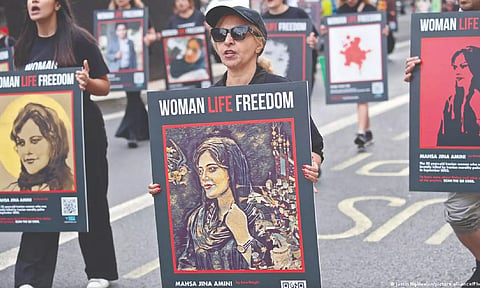One year of shame: Has Iran changed after Mahsa Amini?
• SHABNAM VON HEIN
Ahead of the first anniversary of Jina Mahsa Amini’s death on September 16, her family wrote on Instagram that they intended to mourn at Amini’s grave site. Amini’s relatives, like any grieving family, want to hold a religious and traditional funeral service for their beloved daughter, the statement added. However, since last year, Iranian authorities have closely surveilled Amini’s family. In recent days, armed forces have been deployed around the family’s home in the city of Saqqez, according to reports. Iranian authorities are not only watching Amini’s family. They also monitor many cemeteries where people killed in protests have been laid to rest. Iranian authorities want to prevent crowds, claiming protests could break out.
Exact figures are difficult to obtain, but according to independent human rights organizations, police forces in Iran have killed at least 527 protesters, including 17 minors, during protests between September 16, 2022, and the end of January 2023. Families of people killed during demonstrations are under enormous pressure. “We have never seen this kind of widespread arrest and detention of victims’ family members before,” human rights activist Shiva Nazar Ahari told DW.
Ahari is a member of the Iranian Committee for Human Rights. She has been arrested repeatedly over the past decades and imprisoned for several years. She has lived in Slovenia since October 2018. “So far, more than 40 relatives of the victims have been arrested. And the number of arrests is increasing every day,” Ahari says. “Political and social activists are either in jail, being interrogated or threatened. It may be that these methods temporarily prevent further protests.”
Jina Mahsa Amini was arrested last year during a trip to Tehran, the Iranian capital, and taken to a police station, allegedly for not wearing her headscarf appropriately. In Iran, women are strictly required to wear headscarves in public. A few hours later, Amini was taken lifeless from police custody to the hospital. Three days later, on September 16, she was officially declared dead.
The mass protest movement began with Amini’s funeral in her hometown of Saqqez, located in a Kurdish region in western Iran, and quickly spread throughout the country. The participants, mostly young women, removed their headscarves under the motto: “Woman, Life, Freedom.” These widespread rallies developed into the largest and longest-running protest movement since the founding of the Islamic Republic in 1979. The ruling regime responded with massive repression and violence.
Human rights activist Ahari is convinced that these protests have permanently changed political and social relations in Iranian society.
One of the most significant changes concerns Iranian women taking liberties with their appearance in public. Despite the threat of stricter punitive measures such as fines, many women refuse to wear the mandatory headscarf. They see the headscarf as a symbol of systematic oppression and humiliation and no longer wish to bow to the rules associated with it. Since the Islamic Revolution, the image of women has played an essential role in state ideology. A woman without a hijab is seen as a symbol of a permissive Western lifestyle and is considered by conservative forces to be a cultural attack against Islamic culture.
Iranian women have been discriminated against for several decades in Iran. This is also confirmed by the World Economic Forum Foundation’s (WEF) 2022 Gender Gap Report, with Iran ranking 143 out of 146 countries.

